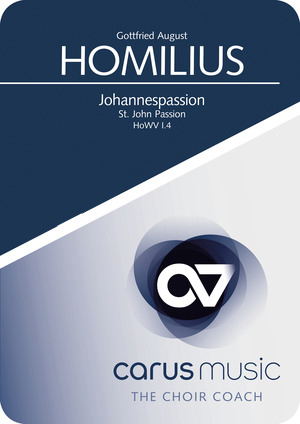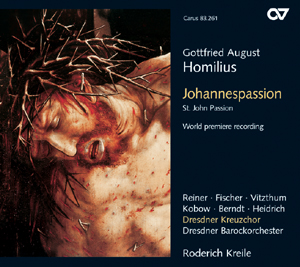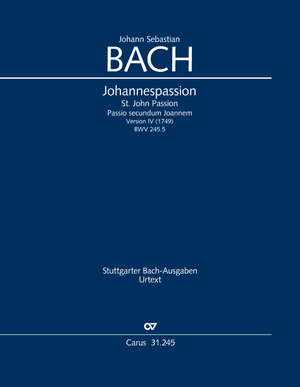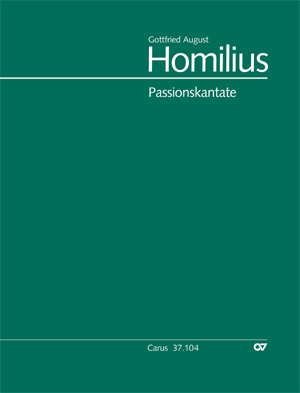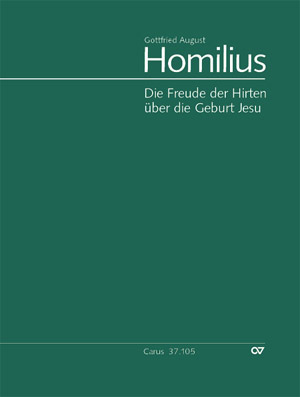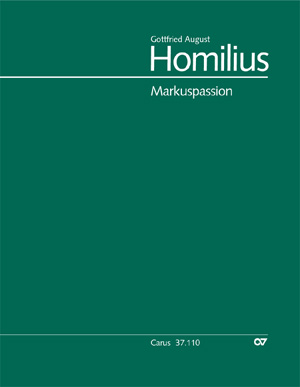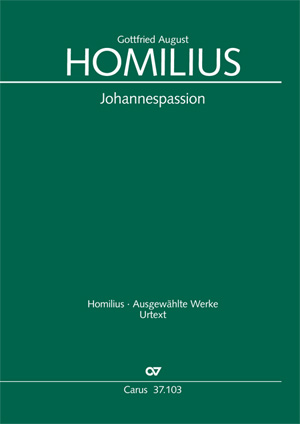
Gottfried August Homilius Passion selon saint Jean
Der Fromme stirbt HoWV I.4
- Effectif:
- Soli SSATB, Coro SATB, 2 Cor, 2 Fl, 2 Ob, 2 Fg, 2 Vl, Va, Bc
- Chercher les œuvres avec un effectif similaire
- Langue:
- Allemand
- Durée:
- 119 min
- Niveau de difficulté:
- 1 2 3 4 5
À une époque où les textes des Passions ne se basaient pratiquement plus sur le texte de la Bible, la mise en musique des texte des Évangiles était encore en usage à Dresde. La Passion selon Saint Jean du Cantor Gottfried August Homilius compte parmi les dernières Passions liées au texte de la Bible. L’alliance de la forme traditionnelle à l’expressivité préclassique de la musique donne une valeur toute particulière à cette oeuvre – l’histoire de la Passion revêt un cachet musical et textuel inhabituel.
 Ecouter
(19)
Ecouter
(19)
- Acheter l´œuvre sous forme de CD ou de fichier à télécharger.
- Choral "Mitten wir im Leben sind"
- Aria "Nun kömmt die Stunde meiner Leiden"
- Choral "Christe, aller Welt Trost"
- Aria "Wer kann den Rat der Liebe Fassen?"
- Aria "Dein Wort ist Geist und Kraft und Segen"
- Aria "Vor dir, dem Vater"
- Choral "Gloria sei dir gesungen"
- Arioso "Den Mörder, Barrabam"
- Aria "Herr, mach dich auf"
- Choral "Unter deinen Schirmen"
- Choral "Weg, Welt, mit deinen Freuden"
- Aria "Ich zage, Herr"
- Aria "Ich bin der Allmächtge"
- Aria "Der Sohn soll sterben"
- Choral "Selig sind, die aus Erbarmen"
- Duetto "Wir weinen dir und deiner Tugend"
- Choral "Schreibe deine blutgen Wunden"
- Aria "Wenn, Heiland, die dich schmähn"
- Coro "O Gottes Lamm"
 Compléments
Compléments
- Acheter des compléments au format téléchargement.
-
 texte (pas de notes) & licence d'impression, fichier html, Paroles, traduction en anglaisfichier html, Paroles, traduction en anglais (Extrait)Part 1 1. Chorale
texte (pas de notes) & licence d'impression, fichier html, Paroles, traduction en anglaisfichier html, Paroles, traduction en anglais (Extrait)Part 1 1. ChoraleThe pious man of righteousness now dies,
2. Recitativo (Evangelist)
the sinner who breaks God’s law survives,
man brings death about, yet evades it;
God is put in chains.When Jesus had spoken these words, he went forth with his disciples over the brook Cedron, where was a garden, into the which he entered, and his disciples. And Judas also, which betrayed him, knew the place: for Jesus ofttimes resorted thither with his disciples. Judas then, having received a band of men and officers from the chief priests and Pharisees, cometh thither with lanterns and torches and weapons.
3. Chorale
John 18:1–3In the midst of life are we surrounded by death.
Whom can we seek to help us find grace?
...
-
 texte (pas de notes) & licence d'impression, fichier html, Paroles, originalfichier html, Paroles, original (Extrait)Teil 1 1. Choral
texte (pas de notes) & licence d'impression, fichier html, Paroles, originalfichier html, Paroles, original (Extrait)Teil 1 1. ChoralDer Fromme stirbt, der recht und richtig wandelt,
2. Recitativo (Evangelist)
der Böse lebt, der wider Gott misshandelt,
der Mensch verwirkt den Tod, und ist entgangen,
Gott wird gefangen.Da Jesus solches geredet hatte, ging er hinaus mit seinen Jüngern über den Bach Kidron, da war ein Garten, darin ging Jesus und seine Jünger. Judas aber, der ihn verriet, wusste den Ort auch, denn Jesus versammelte sich oft daselbst mit seinen Jüngern. Da nun Judas zu sich hatte genommen die Schar und der Hohenpriester und Pharisäer Diener, kömmt er dahin mit Fackeln, Lampen und mit Waffen. Joh 18,1–3
3. ChoralMitten wir im Leben sind mit dem Tod umfangen.
Wen suchen wir, der Hilfe tut, dass wir Gnad erlangen?
Das bist du, Herr, alleine.
...
-
 texte (pas de notes) & licence d'impression, fichier html, Texte introductif, françaisfichier html, Texte introductif, français (Extrait)Avant-propos de l'édition Carus 83.261
texte (pas de notes) & licence d'impression, fichier html, Texte introductif, françaisfichier html, Texte introductif, français (Extrait)Avant-propos de l'édition Carus 83.261Uwe Wolf
Traduction (abregée) : Sylvie CoquillatFils de pasteur, Gottfried August Homilius naît le 2 février 1714 à Rosenthal (Saxe). Il accomplit sa scolarité à l’école Sainte-Anne de Dresde où, bien qu’encore élève, il est déjà chargé de tenir quelquefois l’orgue. En mai 1735, Homilius est immatriculé comme étudiant en droit à l’Université de Leipzig. Etudiant, Homilius travaille également comme musicien à Leipzig et remplace manifestement de temps à autre Johann Schneider, organiste de l’église Saint-Nicolas. Il prend part aux exécutions des œuvres vocales de Johann Sebastian Bach. Selon Johann Adam Hiller, il appartient à Leipzig au cercle direct des élèves de Bach. En 1742, Homilius endosse la fonction d’organiste de la nouvelle église Notre-Dame de Dresde et en 1755 enfin, Homilius succède à Theodor Christlieb Reinhold au poste de cantor de la Sainte-Croix et directeur de la musique des principales églises de Dresde, une fonction qu’il conserve jusqu’à sa mort, le 2 juin 1785.
Les compositions d’Homilius étaient très appréciées et très diffusées à leur époque. Quelques années après la mort d’Homilius (1790), le lexicographe Ernst
...
-
 texte (pas de notes) & licence d'impression, fichier html, Texte introductif, en anglaisfichier html, Texte introductif, en anglais (Extrait)Text form the CD Carus 83.261
texte (pas de notes) & licence d'impression, fichier html, Texte introductif, en anglaisfichier html, Texte introductif, en anglais (Extrait)Text form the CD Carus 83.261Uwe Wolf
Translation (abridged): Peter PalmerThe son of a clergyman, Gottfried August Homilius was born in Rosenthal (Saxony) on 2 February 1714. His schooling was chiefly at the Annen-Schule in Dresden, where he occasionally performed the duties of organist while still a pupil. In May 1735 Homilius matriculated as a law student at the University of Leipzig. He was again active as a musician while in Leipzig and evidently deputized on occasion for Johann Schneider, the organist of the Nikolaikirche. In the process he also took part in the performance of J. S. Bach’s vocal works. According to Johann Adam Hiller, he belonged to Bach’s direct circle of pupils in Leipzig. In 1742 Homilius took up the position of organist at the new Dresden Frauenkirche. In 1755, finally, he succeeded Theodor Christlieb Reinhold as Kreuzkantor and music director of the main Dresden churches – a position he occupied until his death on 2 June 1785.
In their time the compositions of Homilius were very popular and widely disseminated. A few years after Homilius’s death (1790), the lexicographer Ernst Ludwig Gerber even pronounced the judgement: “He was, without argument, our greatest church composer.” Homilius’s vocal works
...
-
 texte (pas de notes) & licence d'impression, fichier html, Texte introductif, en allemandfichier html, Texte introductif, en allemand (Extrait)Booklet-Text der CD Carus 83.261
texte (pas de notes) & licence d'impression, fichier html, Texte introductif, en allemandfichier html, Texte introductif, en allemand (Extrait)Booklet-Text der CD Carus 83.261Uwe Wolf
Gottfried August Homilius wurde am 2. Februar 1714 in Rosenthal (Sachsen) als Sohn eines Pfarrers geboren und erhielt seine Schulausbildung überwiegend an der Annen-Schule in Dresden, wo er bereits als Schüler zeitweilig den Organistendienst übernahm. Im Mai 1735 wurde Homilius als Jura-Student an der Universität Leipzig immatrikuliert. Auch als Student war Homilius musikalisch aktiv und vertrat offenbar zeitweilig den Nikolai-Organisten Johann Schneider. Dabei wirkte er auch an den Aufführungen der Vokalwerke Johann Sebastian Bachs mit. Laut Johann Adam Hiller zählte er in Leipzig zum direkten Schülerkreis Bachs.
1742 konnte Homilius das Amt des Organisten an der neuen Dresdner Frauenkirche übernehmen. In dieser Funktion erwarb er sich den Ruf eines hervorragenden Organisten; es wird berichtet, dass Musikliebhaber die Vespern in der Frauenkirche besuchten, allein um sein Spiel zu hören. 1755 trat Homilius schließlich die Nachfolge Theodor Christlieb Reinholds als Kreuzkantor und Musikdirektor der Dresdner Hauptkirchen an, ein Amt, das er bis zu seinem Tod am 2. Juni 1785 innehatte. Hauptwirkungsstätte war für den Kreuzkantor Homilius jedoch nicht die Kreuz-, sondern die Frauenkirche, da die
...
Sommaire
-
Compositeur
Gottfried August Homilius
| 1714-1785Gottfried August Homilius, the son of a pastor, was born in Rosenthal (Saxony) on 2 February 1714. In May 1735 he enrolled as a law student at Leipzig University. Likewise, it was probably at this time that Homilius was a pupil of Johann Sebastian Bach; the latter fact had been attested to by Johann Adam Hiller. Apart from Bach, Homilius also had contact with Johann Schneider, a Bach pupil and organist at the Nicolaikirche, for whom he also substituted. After unsuccesfully applying for a post as organist in Bautzen, Homilius was appointed organist at the Dresden Frauenkirche in 1742. In 1755 Homilius succeeded Theodor Christlieb Reinhold as Kreuzkantor and music director of the three main churches in Dresden, a position that he occupied until his death on 2 June 1785. Plus d'information sur la personne
-
Éditeur
Uwe Wolf
| 1961Uwe Wolf studied musicology, history, and historical ancillary science at Tübingen and Göttingen. After receiving his doctorate in 1991 he was a research assistant at the Johann-Sebastian-Bach-Institut in Göttingen. From 2004 he worked at the Bach-Archiv Leipzig. There he directed a both research departments, was substantially responsible for the redisigning of the Bach Museum, and he developed the digital Online-Projekt Bach. Since October 2011 he has been the Chief Editor at Carus-Verlag, Stuttgart. He has taught at various universities and also belongs to the editorial boards of several complete editions. Plus d'information sur la personne
Critiques
Die Verbindung von traditioneller Form und empfindsamer, frühklassischer Musik verleiht der Johannespassion des Bach-Schülers ihren besonderen Wert - hier erfährt das Passionsgeschehen musikalisch wie textlich ein neues, außergewöhnliches Gepräge. Die Rolle des Chores ist weitgehend auf die Choräle und Volkschöre beschränkt, lediglich der Schlusschor ist als großer Chor-/Orchestersatz ausgeführt. Gerade bei letzterem zeigt Homilius, warum er besonders als Chorkomponist gerühmt wurde.
Singende Kirche, 54. Jahrgang, Heft 2 2007
Les évaluations sur notre site web ne peuvent être effectuées que par des clients disposant d'un compte d'utilisateur enregistré. Il n'est pas vérifié si les produits évalués ont été effectivement achetés.
Questions fréquentes sur l'œuvre
 Il n'y a pas encore de questions et réponses concernant cette œuvre ou vous n'avez pas trouvé la réponse à votre question sur l'œuvre ? Cliquez ici et envoyez votre question spécifique à notre service clients.
Il n'y a pas encore de questions et réponses concernant cette œuvre ou vous n'avez pas trouvé la réponse à votre question sur l'œuvre ? Cliquez ici et envoyez votre question spécifique à notre service clients.


